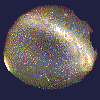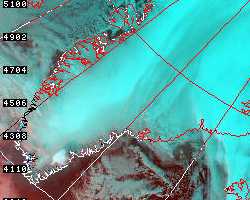


 Because
(non-relativistic) restrictions of space and time, this page won't be updated
never again. It's dead...
Because
(non-relativistic) restrictions of space and time, this page won't be updated
never again. It's dead...

14:24 December 9, 1997
NOAA 14
|
The event occurred on December 9, at
08:21 UTC. At this moment, local solar time was 05:21 A.M. According to
reports, the sky was clear.
Seismic records show a very special event. It lasts more than 10 seconds, indicating a time extended source. It is a high-frequency event, reminiscent of the Lunar meteorite seismic records made by the Apollo missions. This makes phase correlation, hence localization, difficult, but initial indication is that the event occurred in Greenland. A parking lot video surveillence camera in Nuuk, capital of Greenland (64 North, 51 West), recorded an extremely bright flash of light from a moving source. One the footage shown on Danish TV, the event lasted about 2 seconds. However, the time compression factor was not reported. At least two weather satellites show the dramatic development of a cloud system near 63 degrees North 45 degrees West. The clearest images can be obtained from a polar orbiting satellite monitored at the Dundee Satellite Receiving Station. One set of multicolor images show a dark cloud 120 km across, on December 9 14:24 UTC Channel 3 The cloud is still visible 26 hours later, at which moment one can see a 100 km long dark line on the Ice Cap, marking the western edge of the cloud. The line points some 10 degrees West of North, which we interpret as the arrival direction of the meteoroid. The cloud height has been estimated by the Tycho Brahe Planetarium to be 6 - 8 km (based on the shadow cast). The enclosed volume of air is thus at least 50,000 cubic km. If the moist air contains 0.1 gram of water per litre derived either from the meteoroid or from evaporating ice, this amounts to 5 billion tons. The minimum meteorite mass required to melt and evaporate this amount of water is 4 million tons, if the velocity of the impactor was 70 km per second. According to Danish TV (DR1 and TV2 text-tv), a search mission is being planned by the ice service at Narssaq. Old tradition dictates that a fall is named from the closest postal office.This is Qaqortoq, at the south tip of Greenland. The city was formerly called Julianehaab. Copenhagen University Observatory
The above report was compiled using data supplied by Morten
Bo Madsen, Anja Andersen, Torben Risbo, and Lars Lindberg Christensen.
NBIfAFG Copenhagen University Observatory Juliane Maries Vej 30 DK-2100 Copenhagen OE Denmark e-mail holger@astro.ku.dk http://www.astro.ku.dk/~holger/ phone (45) 3532 5980 To the top |